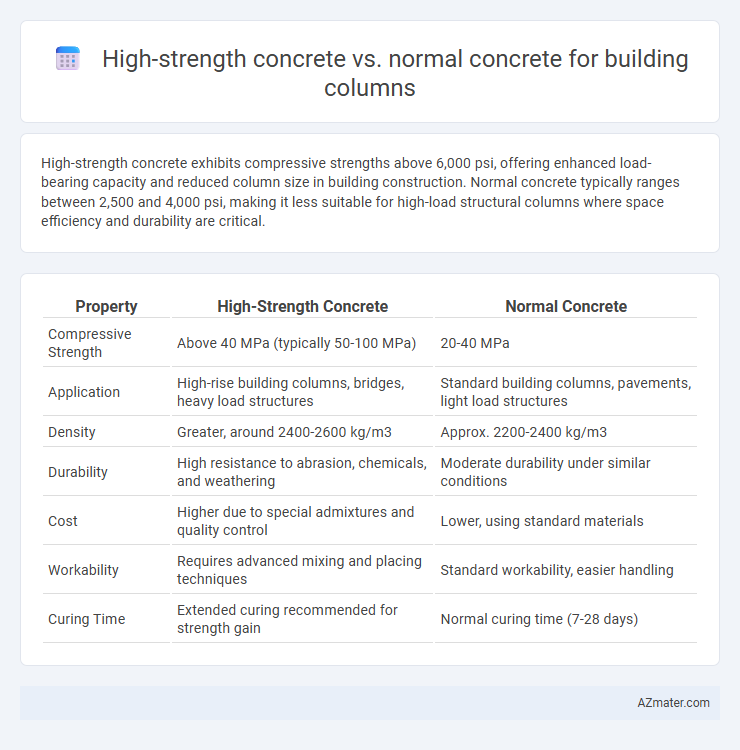High-strength concrete exhibits compressive strengths above 6,000 psi, offering enhanced load-bearing capacity and reduced column size in building construction. Normal concrete typically ranges between 2,500 and 4,000 psi, making it less suitable for high-load structural columns where space efficiency and durability are critical.
Table of Comparison
| Property | High-Strength Concrete | Normal Concrete |
|---|---|---|
| Compressive Strength | Above 40 MPa (typically 50-100 MPa) | 20-40 MPa |
| Application | High-rise building columns, bridges, heavy load structures | Standard building columns, pavements, light load structures |
| Density | Greater, around 2400-2600 kg/m3 | Approx. 2200-2400 kg/m3 |
| Durability | High resistance to abrasion, chemicals, and weathering | Moderate durability under similar conditions |
| Cost | Higher due to special admixtures and quality control | Lower, using standard materials |
| Workability | Requires advanced mixing and placing techniques | Standard workability, easier handling |
| Curing Time | Extended curing recommended for strength gain | Normal curing time (7-28 days) |
Introduction to Concrete Types
High-strength concrete typically exceeds compressive strength of 6000 psi, making it ideal for building columns requiring superior load-bearing capacity and durability. Normal concrete usually ranges from 2500 to 5000 psi, suitable for standard structural applications with moderate stresses. The selection between high-strength and normal concrete directly influences column performance, longevity, and overall structural safety.
Defining High-Strength and Normal Concrete
High-strength concrete is defined by its compressive strength exceeding 6,000 psi (approximately 41 MPa), typically achieved through a carefully engineered mix of low water-to-cement ratio, high-quality cement, and supplementary cementitious materials. Normal concrete, on the other hand, generally possesses compressive strength ranging from 2,500 psi to 5,000 psi (17 to 35 MPa) and is used in standard construction without specialized mix designs. The choice between high-strength and normal concrete for building columns depends on structural requirements, load-bearing capacity, and durability considerations.
Material Composition Differences
High-strength concrete contains higher cement content and lower water-to-cement ratio compared to normal concrete, resulting in increased compressive strength often exceeding 40 MPa. It incorporates supplementary cementitious materials like silica fume or fly ash to enhance durability and reduce porosity, while normal concrete typically uses standard Portland cement and coarser aggregates. The mix design of high-strength concrete emphasizes optimized aggregate grading and chemical admixtures such as superplasticizers to achieve workability without compromising strength.
Strength and Load-Bearing Capacity
High-strength concrete typically achieves compressive strengths above 40 MPa, significantly surpassing normal concrete's average strength of 20-40 MPa, which enhances the load-bearing capacity of building columns. The increased density and reduced permeability of high-strength concrete improve durability and structural performance under heavy loads and stress conditions. Consequently, columns constructed with high-strength concrete can support greater axial and lateral loads, allowing for slimmer designs and more efficient use of space in architectural applications.
Durability and Lifespan
High-strength concrete exhibits superior durability compared to normal concrete due to its reduced permeability and enhanced resistance to chemical attacks, making it ideal for building columns exposed to harsh environmental conditions. The increased compressive strength, often exceeding 50 MPa, contributes to a longer lifespan by minimizing microcracking and structural degradation over time. Normal concrete, typically with compressive strengths around 20-40 MPa, has a shorter lifespan under similar conditions, requiring more frequent maintenance and repair to preserve structural integrity.
Workability and Placement Methods
High-strength concrete (HSC) offers superior compressive strength, typically above 50 MPa, but often exhibits lower workability compared to normal concrete, requiring the use of plasticizers or superplasticizers to maintain flowability during placement. Placement methods for HSC in building columns demand careful vibration and compaction techniques to avoid segregation and ensure uniform density, while normal concrete, with its higher slump, is generally easier to place and consolidate without extensive admixture use. Proper curing practices are critical for HSC to achieve desired mechanical properties and durability in structural columns.
Cost Implications and Budget Considerations
High-strength concrete (HSC) offers superior load-bearing capacity and durability compared to normal concrete, but its production involves higher costs due to advanced materials and mix design requirements. The initial investment in HSC may increase overall project expenses, yet it can reduce long-term maintenance and structural repair costs, potentially balancing budget allocations over the building's lifespan. Budget considerations should weigh the upfront material and labor costs of HSC against the possible savings from enhanced structural performance and extended service life in building columns.
Structural Performance in Columns
High-strength concrete exhibits superior compressive strength, often exceeding 60 MPa, which significantly enhances the load-bearing capacity of building columns compared to normal concrete with compressive strengths around 20-40 MPa. This increased strength improves the column's ability to resist axial loads and reduces column slenderness, contributing to greater structural stability and reduced risk of buckling under high stress. Furthermore, high-strength concrete's improved durability and reduced permeability enhance the long-term performance and resistance to environmental degradation in critical column elements.
Applications in Modern Construction
High-strength concrete, with compressive strengths typically above 6,000 psi, is preferred for building columns in modern construction due to its enhanced load-bearing capacity and durability, enabling slimmer column designs that maximize usable floor space. Normal concrete, usually ranging from 3,000 to 5,000 psi, suits standard building columns where extreme strength is not critical, offering cost-effective and easier workability for residential and low-rise structures. The use of high-strength concrete is crucial in high-rise buildings, infrastructure projects, and areas demanding seismic resistance, where superior mechanical properties contribute to structural safety and longevity.
Conclusion: Choosing the Right Concrete for Columns
High-strength concrete offers superior load-bearing capacity and durability for building columns, making it ideal for high-rise structures and heavy load demands. Normal concrete remains cost-effective and suitable for residential or low-rise buildings with standard load requirements. Selecting the appropriate concrete type depends on structural design, applied loads, and budget considerations to ensure safety and longevity.

Infographic: High-strength concrete vs Normal concrete for Building column
 azmater.com
azmater.com